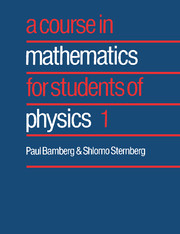Book contents
- Frontmatter
- Contents
- Contents of Volume 2
- Preface
- 1 Linear transformations of the plane
- 2 Eigenvectors and eigenvalues
- 3 Linear differential equations in the plane
- 4 Scalar products
- 5 Calculus in the plane
- 6 Theorems of the differential calculus
- 7 Differential forms and line integrals
- 8 Double integrals
- 9 Gaussian optics
- 10 Vector spaces and linear transformations
- 11 Determinants
- Further reading
- Index
10 - Vector spaces and linear transformations
Published online by Cambridge University Press: 05 August 2013
- Frontmatter
- Contents
- Contents of Volume 2
- Preface
- 1 Linear transformations of the plane
- 2 Eigenvectors and eigenvalues
- 3 Linear differential equations in the plane
- 4 Scalar products
- 5 Calculus in the plane
- 6 Theorems of the differential calculus
- 7 Differential forms and line integrals
- 8 Double integrals
- 9 Gaussian optics
- 10 Vector spaces and linear transformations
- 11 Determinants
- Further reading
- Index
Summary
In Chapter 10 we go back and prove the basic facts about finite-dimensional vector spaces and their linear transformations. The treatment here is a straightforward generalization, in the main, of the results obtained in the first four chapters in the two-dimensional case. The one new algorithm is that of row reduction. Two important new concepts (somewhat hard to get used to at first) are introduced: those of the dual space and the quotient space. These concepts will prove crucial in what follows.
Introduction
We have worked extensively with two-dimensional vector spaces, but so far always with one of two specific models in mind. A vector space V was either the set of displacements in an affine plane, or it was ℝ2, the set of ordered pairs of real numbers. By introducing coordinates, we were able to identify any two-dimensional vector space with ℝ2 and thereby to represent any linear transformation of the space by a 2 × 2 matrix.
We shall now begin to view more general vector spaces from an abstract and axiomatic point of view. The advantage of this approach is that it will permit us to consider vector spaces that are not defined either in geometrical terms or as n-tuples of real numbers. It will turn out that any such vector space containing only a finite number of linearly independent elements can be identified with ℝn for some integer n so that eventually we shall return to the study of ℝn and the use of matrices to represent linear transformations.
Information
- Type
- Chapter
- Information
- A Course in Mathematics for Students of Physics , pp. 340 - 387Publisher: Cambridge University PressPrint publication year: 1988
